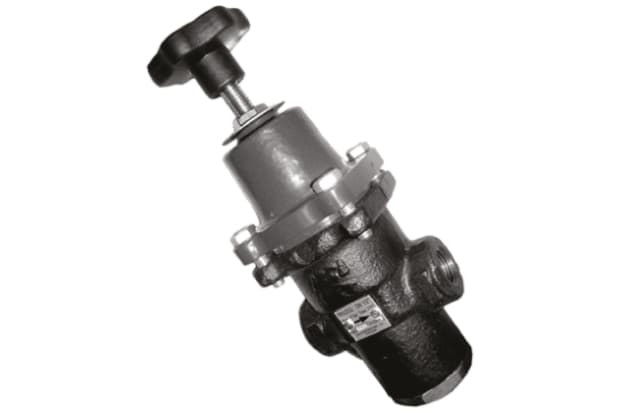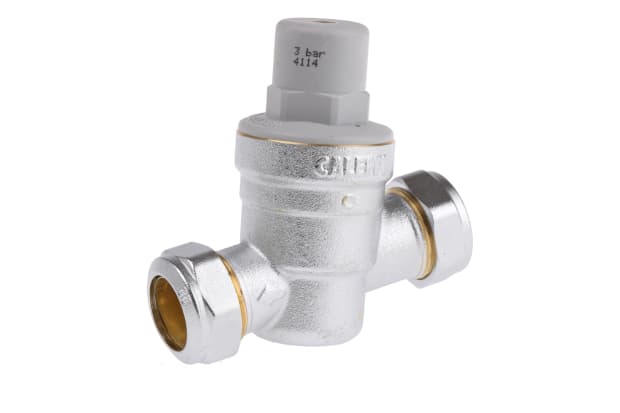- Published 1 Feb 2023
- Last Modified 9 Jul 2024
- 8 min
A Guide to Pressure Reducing Valves
Our pressure reducing valves guide explains what a PRV is, how to use them, and the different types available.

Reviewed by Osman Hafeji, Technical Support Engineer (October 2021)
What is a pressure reducing valve? This guide is designed to provide a comprehensive answer to this question alongside covering the PRV basics. We will offer a simple explanation of how they work, their common applications and functions, and the benefits of using pressure reducing valves in home or industrial installations.
We will also cover some of the various PRV connection types available to buy online. By the end of the guide, you should be familiar with the correct definition of a pressure reducing valve, have a clear idea of what they do, and know how to shop for different models and connection fittings.
What is a Pressure Reducing Valve (PRV)?
Pressure reducing valves are commonly known as PRVs. They sometimes share this acronym with pressure relief or release valves, but it is important to differentiate between the two. For clarity, the latter are frequently labelled SRVs (safety release valves) or PSVs (pressure safety valves). In this guide, PRV means pressure reducing valve.
A pressure reducing valve is used for lowering and regulating water or air pressure between the upstream (inlet) and downstream (outlet) sides. We will discuss their workings in more detail a little later. In summary though, for a typical water installation:
- A PRV will sit in-line on a mains inlet pipe
- It allows the user to adjust the desired outlet/downstream pressure, usually via a dial or wheel on top of the valve
- Once dialled in, the PRV will continually open and close slightly in response to upstream pressure and flow rate
- Its job is to maintain a safe and consistent pressure on the downstream side, under both flow and no-flow conditions, following the parameters set by the user
By contrast, a pressure relief valve refers to a typically automated failsafe device. These are normally designed to offer a path of least resistance in case system pressure rises above a safe maximum, allowing a volume of water/steam to escape suddenly and directly to an outdoor runoff. For sealed plumbing systems, you might see them referred to as blow-off valves. This type of mechanism often needs to be checked and reset after venting.
A pressure reducing valve is instead designed to work continually and incrementally, helping to keep outlet pressure always down to the required level. PRVs feature in many kinds of water installations, including domestic, workplace, industrial and commercial plumbing systems. PRVs are effectively multi-functional - by lowering outlet pressure and flow rate, they also help reduce excessive water consumption and plumbing noise.
Pressure Reducing Valve Basics
Some of the key points important to know about PRVs include:
- They are speciality valves, designed to provide ongoing long-term protection against excessive pressure coming from a mains supply, boosted or tank-fed/gravity source
- They are used on domestic and workplace water installations, both heating systems and drinking water supplies
- Their job is to ensure a suitable water pressure and flow rate is always available to users. They do so by converting high pressure at the valve inlet to significantly lower pressure at the outlet side
- They can be equipped with a gauge that displays the current pressure level, enabling the user to monitor situations in real-time
- Many types of PRV achieve this role under both flow and no-flow conditions. Models that can do this are known as static PRVs, drop-tight valves, or pressure relieving types. They are designed to guard against gradual pressure creep when there is no demand on the outlet side (i.e. when the water is at rest, or static)
- Models that only offer this function under flow conditions, and thus do not prevent pressure creep when there is no demand, are known as dynamic PRVs
- By regulating the pressure within systems and providing a consistent flow rate, they help to reduce both excess water consumption and plumbing noise (such as banging or slamming when flow shuts off)
- Pressure reducing valves also help to prevent damage to water systems and plumbing components, including burst pipes and seals
How Do Pressure Reducing Valves Work?

PRVs work by converting high water pressure at the valve inlet nozzle to lower pressure at the outlet. In the UK, mains supply pressure can vary widely, from 1bar to 20bar or more. It may also fluctuate during periods of higher or lower usage in a given area.
Pressure reducing valves help to regulate these fluctuating mains pressures, keeping them down to an appropriate level during times when they might otherwise build too high. PRVs lower incoming water pressure to a consistent and manageable level via a spring-loaded piston and diaphragm arrangement.
The general mechanism is as follows:
- The user sets the required outlet pressure using a dial or wheel on top of the valve. This, in turn, adjusts the tension on the compression spring that holds the diaphragm in place
- The arrangement is such that water can flow through the valve if upstream pressure remains at or below the level set for downstream pressure. In simple terms, the pressure at these times will not be enough to force the spring back, which would effectively close off the valve. Demand on the outlet side typically causes a pressure drop (often known as fall-off pressure), which will mean the valve remains open. This is an example of dynamic pressure control
- If pressure on the inlet side starts to exceed what is required at the outlet side, it overcomes the tension placed on the valve spring according to the user’s dialled-in settings. The building pressure thus forces the diaphragm to move up, effectively closing the valve
- This often happens more quickly when there is little or no demand from downstream. As such, it can be thought of as an example of static pressure control, where back-pressure on the downstream side helps to keep the valve shut and prevent gradual pressure build-up from the inlet side
Benefits of Using a Pressure Reducing Valve
There are several key benefits of using a pressure reducing valve in domestic, industrial or commercial water installations. These include:
- Limiting excessively high water pressure from a mains, tank or boosted supply that could cause damage to plumbing
- Reducing noise such as hammering or slamming during valve and tap shut-offs, or where the supply is feeding appliances with lower pressure ratings (such as showers, washing machines and dishwashers)
- Achieving a more consistent and comfortable flow rate across a wide range of water uses
- Helping to regulate flow between units, floors and outlet points in larger or older buildings (particularly useful in multi-storey buildings with gravity-fed or boosted supplies)
- Providing static pressure control, and thus helping to guard against gradual pressure creep under low demand/no-flow circumstances
- Lowering pressure to reduce overall water consumption (including wastewater). Higher supply pressure means greater water flow, and increased waste in most cases - the majority of domestic and commercial premises do not require very high water pressure to perform normal tasks comfortably
- Reduced energy costs, as heating systems work more efficiently on water at lower pressures. Roughly 30% of the water used in a typical household is heated to some extent; reducing both pressure and flow rate significantly lowers the amount of energy required to do so
Many types of buildings and water installations may benefit from using a PRV, particularly if the current system shows signs of excessively high pressure. In a typical plumbed water system, these may include:
- Uncomfortable flow rates from indoor taps and showers
- Hammering sounds from pipes or appliances when indoor/outdoor taps or valves close
- Excessive water consumption during normal use
- Leaking or accelerated damage to seals, valves, pipes and plumbing components
If you already have a PRV installed, any of the above could be an indication that it is underperforming or failing, and perhaps overdue for maintenance or replacement. Blockages of the valve mechanism in a PRV can be caused by debris build-up over time, although most high-quality models will include a built-in stainless-steel mesh to help reduce this.
Similarly, the gradual degradation of components such as diaphragms and springs can lead to leakage through the valve in long-term use. This will greatly reduce the overall effectiveness of a pressure reduction valve, and so it is generally recommended to get them properly checked every couple of years in daily use.
Connection Types
There are various types of pressure reducing valves and PRV connections available to buy online in the UK and elsewhere. Among the most common PRV types and connection standards are:

BSP
A PRV BSP fitting is short for British Standard Pipe, a technical standard for screw threading on plumbing pipes and connections. It tends to demote a standard screw-fit male-to-female pipe fitting and a range of standard sizes for both pipe threading and pipe/fastener dimensions.
This type of PRV connection is generally most associated with non-copper fittings, including brass, stainless steel, PVC, galvanised and screwed iron.

Compression
PRV compression fittings are models designed with popular and easy-to-install compression-type joints. These are among the fastest and handiest ways to join ducting or supply pipes together with other components.
They work using an attached collar-style fastener that fits over various diameters of hard copper pipe, plastic, and soft tubing runs. The sleeve or ferrule of a compression fitting slides over the pipe, and then a nut is placed over this arrangement which helps to clamp down the fitting around the joint.
Related Guides
Related links
- Pressure Reducing Valves
- A Complete Guide to Pressure Relief Valves
- Hydraulic Pressure Reducing Valves
- Watts Pressure Reducing Valve
- RS PRO Pressure Reducing Valve, 22 mm Compression
- RS PRO Pressure Reducing Valve, 1/2 in BSP Female
- RS PRO Pressure Reducing Valve, 1 in BSP Female
- RS PRO Pressure Reducing Valve, 15 mm Compression


